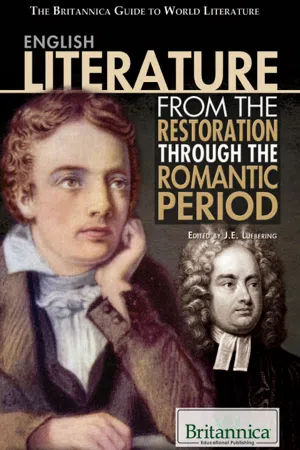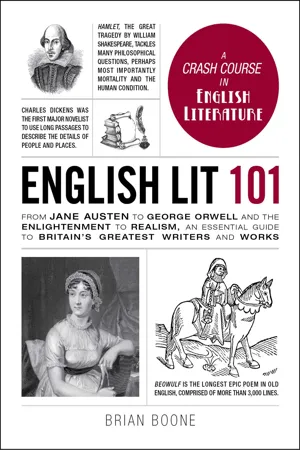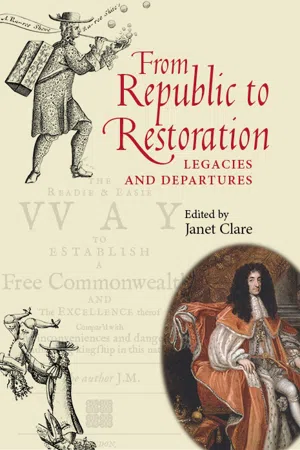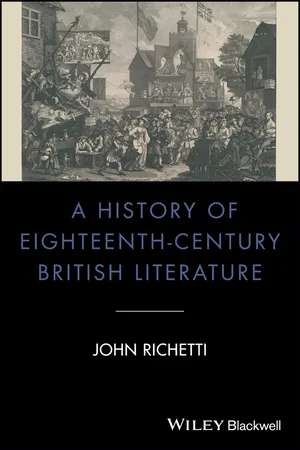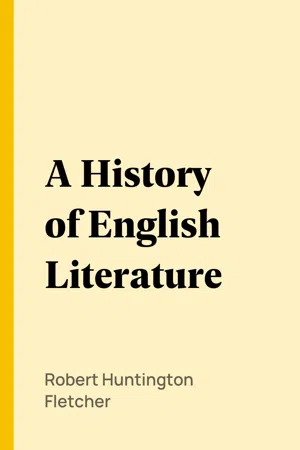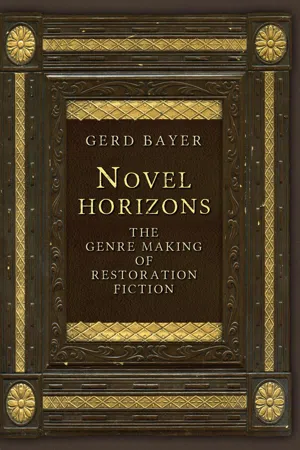Literature
The Restoration
The Restoration refers to the period in English history from 1660 to 1688 when the monarchy was restored, marking the return of King Charles II to the throne. This era is known for its significant impact on literature, particularly the flourishing of drama and comedy, as well as the emergence of the novel as a literary form.
Written by Perlego with AI-assistance
Related key terms
Related key terms
1 of 4
Related key terms
1 of 3
8 Key excerpts on "The Restoration"
- Britannica Educational Publishing, J.E. Luebering(Authors)
- 2010(Publication Date)
- Britannica Educational Publishing(Publisher)
CHAPTER 1RESTORATION LITERATURET he term Restoration literature refers to literature written after The Restoration of the English monarchy in 1660. Many of the literary forms considered typical of the modern world—including the novel, biography, history, travel writing, and journalism—were either invented or reached maturity in the late 17th century. Writers in all of these forms gained confidence, and wider readerships, during The Restoration period, when new scientific discoveries and philosophical concepts, as well as new social and economic conditions, came into play. There was a great outpouring of pamphlet literature, too, much of it politico-religious, while John Bunyan’s great allegory, Pilgrim’s Progress , also belongs to this period. Much of the best poetry, notably that of John Dryden (the great literary figure of his time, in both poetry and prose), was satirical and led directly to the later achievements of Alexander Pope, Jonathan Swift, and John Gay in the 18th century. The Restoration period was, above all, a great age of drama. Heroic plays, influenced by principles of French Neoclassicism, enjoyed a vogue, but the age is chiefly remembered for its glittering, critical comedies of manners by such playwrights as George Etherege, William Wycherley, Sir John Vanbrugh, and William Congreve.For some, The Restoration of King Charles II in 1660 led to a painful revaluation of the political hopes and millenarian expectations bred during two decades that witnessed the violence and disorder of the English Civil Wars (1642–51) and the subsequent emergence of republican government under Oliver Cromwell. For others, it excited the desire to celebrate kingship and even to turn the events of the new reign into signs of a divinely ordained scheme of things. Violent political conflict may have ceased, but the division between royalists and republicans still ran through literature of the period. Indeed, it is hard to conceive of a single literary culture that could include, on the one hand, Bunyan and John Milton and, on the other, Dryden and John Wilmot, earl of Rochester. Yet these and other such opposites were writing at the same time.- eBook - ePub
English Lit 101
From Jane Austen to George Orwell and the Enlightenment to Realism, an essential guide to Britain's greatest writers and works
- Brian Boone(Author)
- 2017(Publication Date)
- Adams Media(Publisher)
Chapter 3
The Restoration and Beyond
To understand the literature of the seventeenth and eighteenth centuries, you have to understand what was going on in English history during this time period, which was the nation’s most chaotic and violent era.The English Civil War (1642–1651) was fought over the nature of government: an absolute monarchy (in which a king or queen had all of the power) versus a commonwealth (in which the people, by way of elected or appointed officials, have the power). Those in favor of a commonwealth won, and as a result King Charles I lost his head and Oliver Cromwell was placed in charge of the country. The new way didn’t work either, and after a decade as Lord Protector, Oliver Cromwell was beheaded, albeit posthumously.King Charles II, son of King Charles I, the last ruler before Cromwell, was crowned in 1660 and restored the monarchy to England. It’s an event now known as The Restoration. King Charles II had spent his exile in France, and upon his return he brought French culture into English culture: massive wigs, fancy clothes, and an appreciation for decadence and leisure. The writers of the era, of course, were skeptical of this new jubilant attitude. They spoke for those scarred by all of the political and actual battles of the recent past. In literature, this skepticism manifested as satire (Henry Fielding), a call to return to classical ideals (Alexander Pope), and a curiosity about the great big world outside of England (Daniel Defoe).But then Charles II died in 1685 and was succeeded by his Scottish Catholic brother, King James II. Those who feared that England would return to oppressive rule from afar by the Catholic Church instigated the “Glorious Revolution” and installed Protestant noble William of Orange of the Netherlands on the throne. He quickly approved a Bill of Rights, which limited a monarch’s power and increased the power of Parliament. That system dovetailed nicely with the Age of Enlightenment sweeping across Europe and England in which thinkers like John Locke advocated a scientific approach and a dedication to reason in all things, including the underlying idea that all men are equal. Those optimistic philosophical themes, as well as a sense that humanity was finally “waking up” to its true nature is pervasive in the literature of the era, in everything from the crusading satire of Jonathan Swift to the thoughtful, divinity-based poetry of John Milton. - eBook - ePub
From Republic to Restoration
Legacies and departures
- Janet Clare(Author)
- 2018(Publication Date)
- Manchester University Press(Publisher)
Introduction: from Republic to Restoration Janet Clare From Republic to Restoration brings together the work of historians, literary scholars, cultural and music historians with a shared interest in the crossing of the common period boundary of 1660. While recent, more inclusive studies of the seventeenth century have dislodged 1660 as a rigid historiographical divide, relatively few critics have examined the continuum of Republic to Restoration, investigating the features of The Restoration in the context of the legacies, traumas and achievements of the Republic. 1 On one level, such a historiographical treatment of the seventeenth century may be seen as an acceptance of the political discourse which accompanied the return of kingship in 1660, mirroring The Restoration’s repudiation or casting into oblivion the entire social order preceding it. Charles II dated his reign from 1649 and ignored the so-called Interregnum in his regnal years calculation. But, as C. V. Wedgwood argued over half a century ago, ‘the problems and achievements of The Restoration epoch, including Parliament, the Church, social or economic history, literature, the arts and the sciences have their beginnings in the earlier period’. 2 Historians and scholars of theatre, drama and the arts who end or begin their work at The Restoration can obscure continuities between the first and second halves of the seventeenth century. As chapters in this volume illustrate, reconstruction of the old order did not mend the political, religious and cultural divisions that had opened up during the civil wars. Nor did the political experiments and the artistic and scientific achievements of the 1650s fail to leave an imprint on the rest of the century. While there might have been an understandable reluctance to lay claim to the legacies of the Republic, at various moments in The Restoration there was a resurfacing of ideologies and genres formulated during the previous decades - eBook - ePub
A Nation of Change and Novelty
Radical Politics, Religion and Literature in Seventeenth-Century England
- Christopher Hill(Author)
- 2023(Publication Date)
- Routledge(Publisher)
et al. (eds) The Revels History of Drama in England, II, 1500-1576, 1980, p. 193. Cf. pp. 83-4 above.58 Cf. Jose, Ideas of The Restoration, op. cit ., pp. 172-4.59 Anon., The Coming of Christs Appearing in Glory and its Shortly Breaking Forth, quoted by H.A. Glass, The Barebone Parliament, 1899, p. 52.60 Margoliouth (ed.) Marvell, Poems and Letters, I, p. 112. For Marvell see M. Stocker, Apocalyptic Marvell: The Second Coming in 17th Century Poetry, Brighton, 1986, Ch. 5.61 Harrington, Political Works, op. cit ., pp. 329-33.62 McKeon, Politics and Poetry, op. cit ., passim; Zwicker, Politics and Language, op. cit ., pp. 74, 82.63 Dryden, Of Dramatic Poesy and Other Critical Essays, Everyman edn, I, p. 18. First published 1668.So I want to insist that The Restoration was not a return to 1640, but continued the tradition of the fifties. Here are some further examples from literature:In the 1640s popular journalists created a new kind of prose, written in the conversational language of ordinary people. That was necessary if propaganda was to reach the man in the street, as in the forties for the first time it had to, since the man in the street was no longer being told that the mysteries of state were not his concern. Instead, he was being urged to fight, to pay taxes, to suffer billeting and free quarter: both sides wished to convince him that their cause justified his sacrifices. The royalist Berkenhead no less than the (ultimately) parliamentarian Marchamont Nedham played a part in this evolution of a simpler, more direct and forceful prose.64 James Sutherland pointed out that shortage of space encouraged The Restoration newswriter to express himself succinctly and fluently, often quoting the exact words of his correspondents.65 And Defoe noted that English prose style had changed more in the fifty or sixty years before he wrote than in the preceding century.66 - John Richetti(Author)
- 2017(Publication Date)
- Wiley-Blackwell(Publisher)
10 Eighteenth‐Century Drama : Sentimental Pathos, Melodrama, and HumorI. Restoration Re‐establishment of the English Theater
Not long after the spectacular florescence of English drama in Elizabethan and Jacobean London (Shakespeare, Jonson, and many other playwrights) that extended into the early years of the reign of Charles I, 1625–41, the theaters in the city were shut down in 1642 by the Puritan political leaders in Parliament as the English Civil War began. When the monarchy was restored in 1660, Charles II granted “letters patent” to Thomas Killigrew and Sir William Davenant for the creation of two theater companies in London, the King’s (named after Charles) and the Duke of York’s (named for James, the king’s brother). Although substantial opposition to theatrical presentations as promoting immorality from some religious commentators continued (the most famous if ineffective protest was Jeremy Collier’s 1698 polemic, A Short View of the Immorality and Profaneness of the English Stage), the revived Restoration theater, thanks to royal patronage, at least until the death of King Charles in 1685, quickly became a lively, popular scene of entertainment in London, with redesigned, enlarged theaters, lavish spectacles, musical accompaniment, and dancing, as well as elaborate movable scenery. The period is notable for racy comedies of sexual and marital intrigue by John Dryden, George Etherege, John Vanbrugh, William Wycherley, Aphra Behn, George Farquhar, William Congreve, among many others, and for so‐called “heroic” or operatically broad and extravagant tragedies, often in rhyming couplets or in blank verse, such as Dryden’s The Conquest of Granada (1672) and Aureng‐zeb (1675), Nathaniel Lee’s The Rival Queens, or The Death of Alexander the Great (1677) and Lucius Junius Brutus, Father of His Country (1680), Thomas Otway’s The Orphan, or The Unhappy Marriage (1680), and his Venice Preserv’d; Or a Plot Discover’d- eBook - ePub
English Drama
Restoration and Eighteenth Century 1660-1789
- Richard W. Bevis(Author)
- 2014(Publication Date)
- Routledge(Publisher)
A more lasting threat to conventional Christianity was the rise of empirical science. The Royal Society (founded 1660) took over from Bacon, Galileo, and Descartes the annoying habit of accepting nothing as proven until it could be demonstrated; satirists (including Thomas Shadwell) attacked its experiments and its insistence on simple language. Not surprisingly in a time of deeply felt and strongly reasoned but antithetical views, the old philosophy of scepticism found new adherents inclined to distrust all speculative assertions. 8 What was confusing was that some sceptics turned to science, some to Christianity, and some to Hobbes. The tension between appearance and reality – or the real and the ideal – has been the basic theme of Western literature, though its strength and form have varied. During ages of social and ideological stress, such as The Restoration, a great many cracks in a culture’s unity need to be papered over or hidden behind the furniture, or as a last resort absolutely denied. Potentially dangerous conflicts may have to be circumvented rather than confronted. Not only faces but words and intentions must be masked. Of course appearances are proverbially deceiving, and drama generally makes free use of concealment and deception, but the sheer number of masks, veils, fans, screens, aliases, impersonations, ironic colloquies, and feigned appearances on The Restoration stage is impressive: a useful reminder that we are entering what is often called the ‘age of irony’ or the ‘age of disguise’. 9 Restoration audiences There is much dispute about the nature of The Restoration audience, but none about the existence of a close connection between drama and the Court. King Charles II, a friend to drama before 1660, remained its premier patron, socializing with playwrights, donating properties to actors and visiting the theatre frequently. When he attended, the house was fuller; when he smiled, the house smiled with him - eBook - ePub
- Robert Huntington Fletcher(Author)
- 2005(Publication Date)
- Perlego(Publisher)
THE OTHER DRAMATISTS. The other dramatists of The Restoration period may be dismissed with a few words. In tragedy the overdrawn but powerful plays of Thomas Otway, a man of short and pathetic life, and of Nathaniel Lee, are alone of any importance. In comedy, during the first part of the period, stand Sir George Etherege and William Wycherley. The latter's 'Country Wife' has been called the most heartless play ever written. To the next generation and the end of the period (or rather of The Restoration literature, which actually lasted somewhat beyond 1700), belong William Congreve, a master of sparkling wit, Sir John Vanbrugh, and George Farquhar. So corrupt a form of writing as The Restoration comedy could not continue to flaunt itself indefinitely. The growing indignation was voiced from time to time in published protests, of which the last, in 1698, was the over-zealous but powerful 'Short View of the Immorality and Profaneness of the English Stage' by Jeremy Collier, which carried the more weight because the author was not a Puritan but a High-Church bishop and partisan of the Stuarts. Partly as a result of such attacks and partly by the natural course of events the pendulum, by the end of the period, was swinging back, and not long thereafter Restoration comedy died and the stage was left free for more decent, though, as it proved, not for greater, productions.CHAPTER IX
PERIOD VII. THE EIGHTEENTH CENTURY. PSEUDO-CLASSICISM AND THE BEGINNINGS OF MODERN ROMANTICISM [Footnote: Thackeray's 'Henry Esmond' is the greatest historical novel relating to the early eighteenth century.]POLITICAL CONDITIONS. During the first part of the eighteenth century the direct connection between politics and literature was closer than at any previous period of English life; for the practical spirit of the previous generation continued to prevail, so that the chief writers were very ready to concern themselves with the affairs of State, and in the uncertain strife of parties ministers were glad to enlist their aid. On the death of King William in 1702, Anne, sister of his wife Queen Mary and daughter of James II, became Queen. Unlike King William she was a Tory and at first filled offices with members of that party. But the English campaigns under the Duke of Marlborough against Louis XIV were supported by the Whigs, [Footnote: The Tories were the political ancestors of the present-day Conservatives; the Whigs of the Liberals.] who therefore gradually regained control, and in 1708 the Queen had to submit to a Whig ministry. She succeeded in ousting them in 1710, and a Tory cabinet was formed by Henry Harley (afterwards Earl of Oxford) and Henry St. John (afterwards Viscount Bolingbroke). On the death of Anne in 1714 Bolingbroke, with other Tories, was intriguing for a second restoration of the Stuarts in the person of the son of James II (the 'Old Pretender'). But the nation decided for a Protestant German prince, a descendant of James I through his daughter Elizabeth, [Footnote: The subject of Wotton's fine poem, above, p. 158.] and this prince was crowned as George I—an event which brought England peace at the price of a century of rule by an unenlightened and sordid foreign dynasty. The Tories were violently turned out of office; Oxford was imprisoned, and Bolingbroke, having fled to the Pretender, was declared a traitor. Ten years later he was allowed to come back and attempted to oppose Robert Walpole, the Whig statesman who for twenty years governed England in the name of the first two Georges; but in the upshot Bolingbroke was again obliged to retire to France. How closely these events were connected with the fortunes of the foremost authors we shall see as we proceed. - eBook - ePub
Novel horizons
The genre making of Restoration fiction
- Gerd Bayer(Author)
- 2016(Publication Date)
- Manchester University Press(Publisher)
Part III The Restoration novel Introduction The Restoration novel, if it at all existed as a genre, was clearly marked by its heterogeneity, in terms of both its formal and its thematic content. Authors, booksellers, and readers were willing to entertain a wide range of different texts that fall under the header narrative prose fiction. Book catalogues and booksellers’ advertisements at the time do not use this general term, but instead refer to histories, romances, or intrigues, mostly avoiding the term novel. 1 This third part to Novel horizons concentrates on a small number of features as a means to discuss the actual formal properties of narrative prose fiction written during The Restoration. While the selected features by no means suffice in terms of defining what the novel at the time may have meant to its readers, it does shed light on the generic competence of the literary audience at the time. This final part accordingly tests the findings from the previous part, on the paratextual poetics of Restoration drama and prose fiction, against the actual reality of the works published at the time. Drawing on a wide selection of fictions published between 1660 and 1710, the three chapters below each concentrate on one particular aspect of prose narratives and discuss a wide range of formal features such as narrative point of view (Chapter 6), character development (Chapter 7), and the relationship between the fictional worlds and the actual reality of their readers (Chapter 8). While these three areas only present a small segment of what makes of narrative prose fiction a coherent group within the larger system of literary texts, they claim a prominent position when it comes to distinguishing the novel from other major genres, such as drama and poetry
Index pages curate the most relevant extracts from our library of academic textbooks. They’ve been created using an in-house natural language model (NLM), each adding context and meaning to key research topics.
Explore more topic indexes
Explore more topic indexes
1 of 6
Explore more topic indexes
1 of 4
